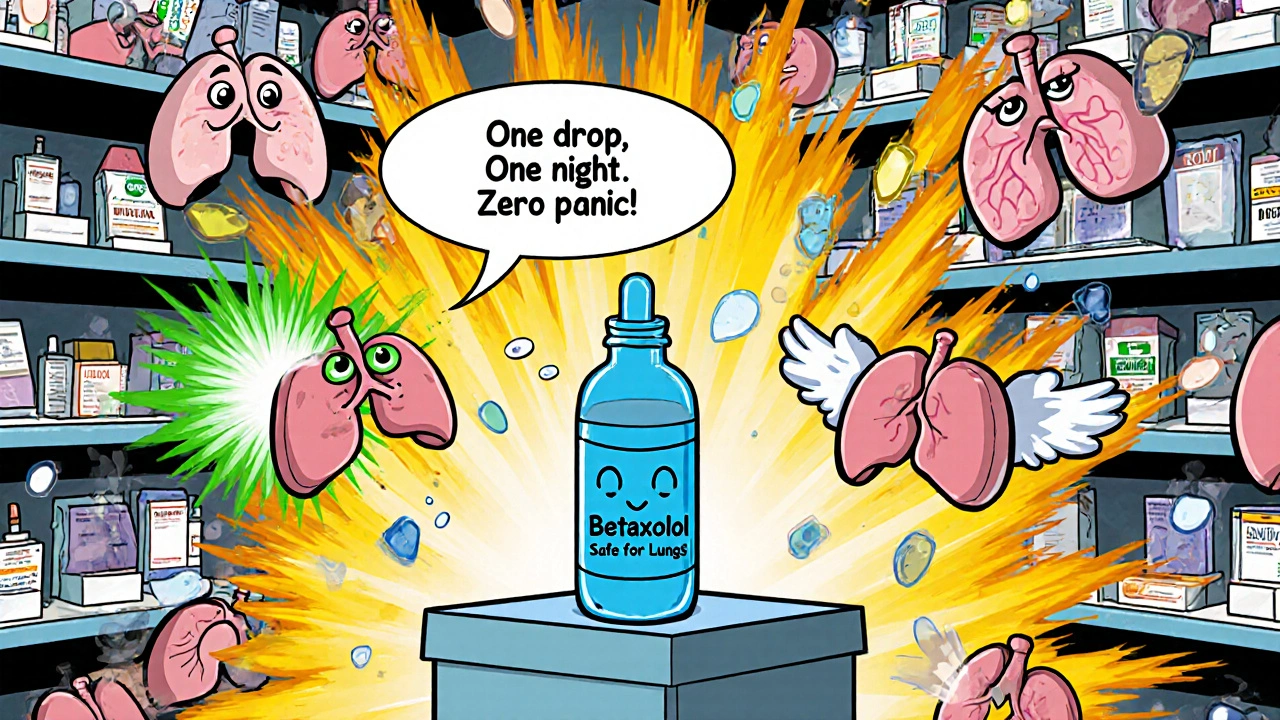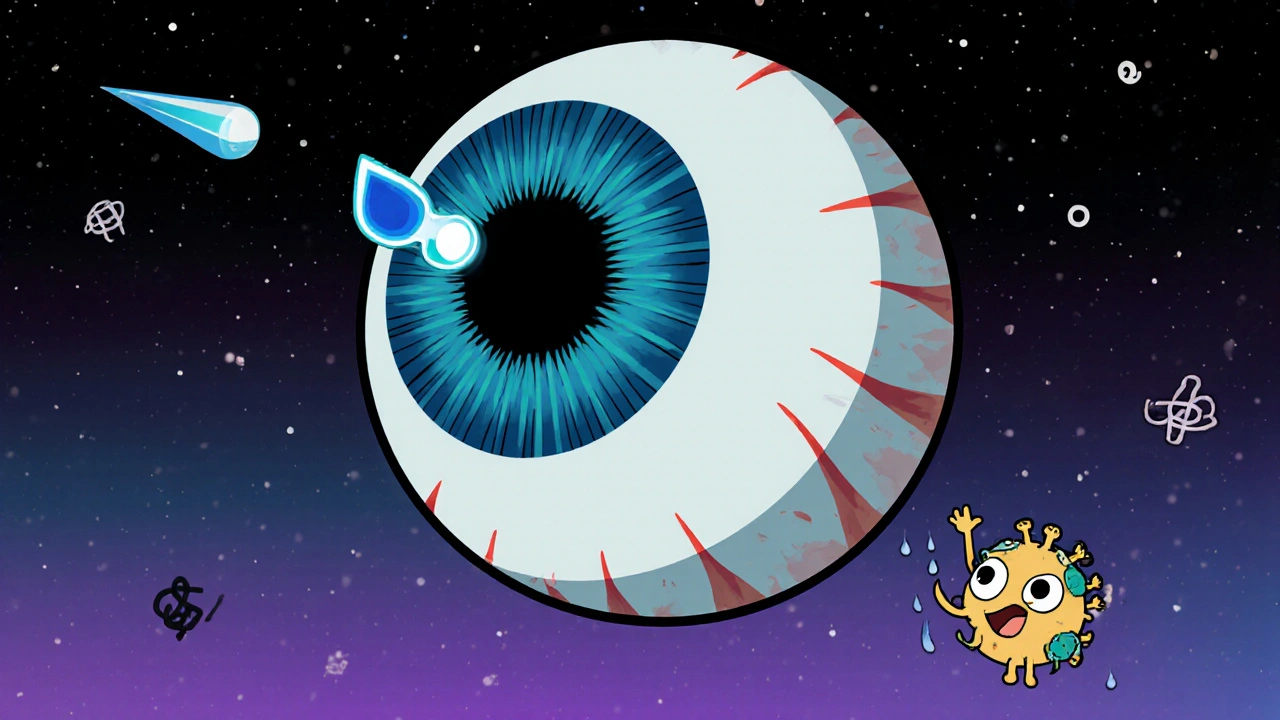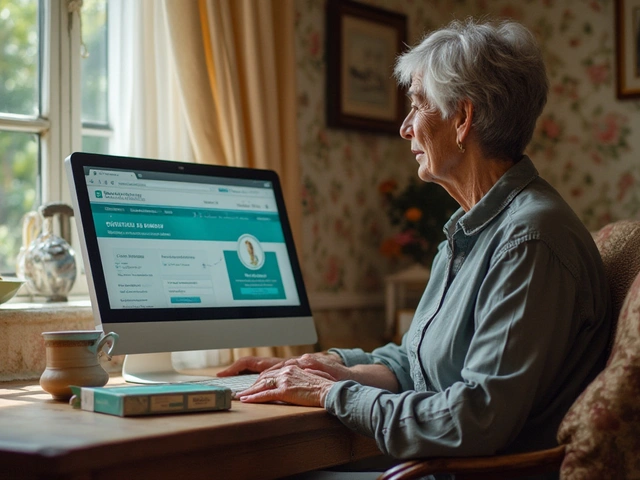Glaucoma doesn’t always cause symptoms until it’s too late. By the time vision loss becomes obvious, damage to the optic nerve is often permanent. That’s why controlling intraocular pressure is critical-and for many people, betaxolol eye drops are a key part of that fight.
What is betaxolol and how does it help glaucoma?
Betaxolol is a selective beta-1 adrenergic blocker, originally developed as a heart medication. But doctors noticed something interesting: when applied as eye drops, it lowered pressure inside the eye. That led to its use in treating glaucoma and ocular hypertension.
Inside the eye, fluid called aqueous humor is constantly made and drained. When drainage gets blocked or slowed, pressure builds up. That pressure crushes the optic nerve over time. Betaxolol doesn’t open the drainage channels. Instead, it reduces how much fluid the eye produces. Less fluid means lower pressure-slowing down nerve damage.
Unlike older beta blockers like timolol, betaxolol is selective. It mainly targets beta-1 receptors in the eye, not beta-2 receptors in the lungs. That makes it safer for people with asthma or chronic bronchitis. It’s not a cure, but it’s a tool that can help preserve vision for years if used correctly.
How effective is betaxolol at lowering eye pressure?
Studies show betaxolol typically reduces intraocular pressure by 15% to 25% in most patients. That’s less than timolol, which can drop pressure by 25% to 30%. But for some people, that 15% drop is enough-especially if they can’t tolerate other medications.
A 2022 clinical review in the Journal of Glaucoma found that patients using betaxolol once daily maintained stable pressure for up to 12 months. The effect lasts about 24 hours, which is why most doctors prescribe it as a single daily dose. That’s easier than multiple drops a day, and better for adherence.
It works best when used consistently. Skipping doses-even just once or twice a week-can cause pressure to creep back up. Glaucoma doesn’t wait. Neither should you.
Who is betaxolol best for?
Betaxolol isn’t the first-line choice for everyone. But it shines in specific cases:
- People with asthma, COPD, or other lung conditions-because it’s less likely to trigger bronchospasm than non-selective beta blockers.
- Patients who can’t tolerate other eye drops due to redness, stinging, or allergic reactions.
- Those already on oral beta blockers for heart conditions, where adding another non-selective beta blocker could be risky.
- People with mild to moderate open-angle glaucoma who need a gentle, long-lasting option.
It’s not ideal for advanced glaucoma where pressure needs to drop dramatically. In those cases, doctors usually combine betaxolol with other drugs like prostaglandin analogs or carbonic anhydrase inhibitors.
How to use betaxolol eye drops correctly
Getting the most out of betaxolol isn’t just about taking it-it’s about using it right.
- Wash your hands before handling the bottle.
- Tilt your head back and pull down your lower eyelid to form a pocket.
- Hold the dropper close to your eye-don’t let it touch your skin or eyelashes.
- Release one drop into the pocket. Close your eye gently for 1 to 2 minutes.
- Press the inner corner of your eye near your nose with a finger. This blocks the tear duct and keeps more medicine in your eye.
- Wait at least 5 minutes before applying another eye drop, if needed.
Using the pressure technique (step 5) can increase the amount of drug absorbed by up to 80%. That means better results and less waste. Many patients skip this step-and lose the full benefit.

Side effects and risks
Betaxolol is generally well-tolerated, but it’s not without risks.
Common side effects include:
- Eye irritation, burning, or stinging (usually fades after a few days)
- Blurred vision right after application
- Dry eyes or watery eyes
- Headache or dizziness
Less common but more serious effects include:
- Slow heart rate (bradycardia)
- Low blood pressure
- Worsening heart failure in people with existing conditions
- Depression or fatigue (rare, but reported in some users)
If you feel unusually tired, dizzy, or notice your heart beating slower than normal, talk to your doctor. These aren’t common, but they can happen-especially if you’re also taking oral beta blockers or other heart medications.
Don’t stop using betaxolol suddenly. Abruptly stopping can cause a rebound increase in eye pressure. Always taper under medical supervision.
Drug interactions to watch for
Betaxolol can interact with other medications, especially those that affect your heart or blood pressure.
Be cautious if you’re taking:
- Other beta blockers (oral or eye drops)
- Calcium channel blockers like verapamil or diltiazem
- Antiarrhythmics like digoxin
- Antidepressants, especially MAO inhibitors
- Insulin or oral diabetes medications (beta blockers can mask low blood sugar symptoms)
Always tell your eye doctor and primary care provider about every medication you take-including supplements and over-the-counter drugs. Many people don’t realize eye drops can have systemic effects.
How betaxolol compares to other glaucoma treatments
There are several classes of glaucoma eye drops. Here’s how betaxolol stacks up:
| Medication | Class | Pressure Reduction | Dosing Frequency | Best For | Key Risks |
|---|---|---|---|---|---|
| Betaxolol | Selective beta blocker | 15-25% | Once daily | Lung conditions, mild glaucoma | Slow heart rate, fatigue |
| Timolol | Non-selective beta blocker | 25-30% | Twice daily | Strong pressure control | Asthma, bronchospasm |
| Latanoprost | Prostaglandin analog | 25-35% | Once daily | First-line for most patients | Eye color change, eyelash growth |
| Dorzolamide | Carbonic anhydrase inhibitor | 15-20% | Three times daily | Combination therapy | Bitter taste, tingling |
| Brimonidine | Alpha agonist | 20-25% | Twice daily | Patients with mild glaucoma | Drowsiness, dry mouth |
Latoprost is now the most common first choice because it’s more effective and easier to use. But betaxolol still has a place-especially when safety matters more than maximum pressure drop.

What if betaxolol doesn’t work?
Not everyone responds to betaxolol. If your eye pressure stays high after 4 to 6 weeks, your doctor will likely adjust your treatment.
Options include:
- Adding another drop (like latanoprost or dorzolamide)
- Switching to a different beta blocker
- Trying laser treatment (selective laser trabeculoplasty)
- Moving to surgery if pressure remains uncontrolled
Combination therapy is common. Many people need two or even three types of drops to keep pressure in check. The goal isn’t perfection-it’s preventing vision loss.
Long-term use and monitoring
Betaxolol is safe for long-term use. But glaucoma is a lifelong condition. That means regular checkups are non-negotiable.
You should have:
- Eye pressure checks every 3 to 6 months
- Optic nerve imaging (OCT scans) at least once a year
- Visual field tests to track peripheral vision loss
Even if you feel fine, these tests catch damage before you notice it. Glaucoma steals vision silently. Monitoring is your best defense.
Real-world tips for staying on track
Sticking to eye drops for years is harder than it sounds. Life gets busy. You forget. You run out. You get tired of the stinging.
Here’s what actually works:
- Keep your drops next to your toothbrush or alarm clock-link them to a daily habit.
- Use a pill organizer with a reminder alarm if you take multiple medications.
- Always carry a spare bottle in your bag or car.
- Set a weekly refill reminder on your phone.
- Don’t wait until you’re out to call your pharmacy. Reorder when you have 3 days left.
One patient I spoke with said she kept her drops in her purse and used them every time she checked her phone. That small trick kept her pressure stable for 8 years.
Final thoughts: Is betaxolol right for you?
Betaxolol isn’t the most powerful glaucoma drug. But it’s one of the safest for people with breathing problems. It’s reliable, long-lasting, and gentle. For many, it’s the difference between preserving vision and losing it.
The key is consistency. Use it every day. Show up for your eye exams. Talk to your doctor if something feels off. Glaucoma doesn’t care how busy you are. But you can still win this fight-one drop at a time.
Can betaxolol cure glaucoma?
No, betaxolol cannot cure glaucoma. It helps control intraocular pressure to slow or stop further damage to the optic nerve. Glaucoma is a chronic condition that requires lifelong management. The goal of treatment is to preserve existing vision, not restore lost vision.
How long does it take for betaxolol to start working?
Betaxolol begins lowering eye pressure within 1 hour after application. Peak effect occurs around 2 hours later, and the pressure-lowering effect lasts for about 24 hours. This is why it’s typically prescribed as a once-daily dose.
Can I use betaxolol if I have asthma?
Yes, betaxolol is often preferred over non-selective beta blockers like timolol for people with asthma or COPD. It’s a selective beta-1 blocker, meaning it has less effect on the lungs. However, you should still be monitored by your doctor, as individual reactions can vary.
What happens if I miss a dose of betaxolol?
If you miss a dose, apply it as soon as you remember. If it’s almost time for your next dose, skip the missed one and go back to your regular schedule. Don’t double the dose to make up for it. Missing doses occasionally won’t cause immediate damage, but frequent missed doses can lead to rising eye pressure and increased risk of vision loss.
Can betaxolol cause changes in eye color?
No, betaxolol does not cause changes in eye color. This side effect is associated with prostaglandin analogs like latanoprost, which can darken the iris over time. Betaxolol works by reducing fluid production, not by affecting pigment cells in the eye.
Is betaxolol safe during pregnancy?
Betaxolol is classified as Pregnancy Category C. Animal studies have shown adverse effects on the fetus, but there are no adequate human studies. If you’re pregnant or planning to become pregnant, discuss the risks and benefits with your doctor. In some cases, alternative treatments may be recommended.
Can I wear contact lenses while using betaxolol?
Remove your contact lenses before applying betaxolol. Wait at least 15 minutes after using the drops before putting your lenses back in. Some formulations contain preservatives that can be absorbed by soft contact lenses and cause irritation.
Does betaxolol interact with alcohol?
Alcohol doesn’t directly interfere with betaxolol’s eye pressure-lowering effect. But both can lower blood pressure, so combining them may increase dizziness or lightheadedness. Use alcohol in moderation, and avoid driving or operating machinery if you feel faint.
If you’re on betaxolol, you’re not alone. Millions use it to protect their sight. The science is clear: consistent use saves vision. The rest is up to you.




Emily Barfield
November 4, 2025 AT 12:22It’s fascinating how a drug designed for the heart ended up saving sight-nature’s irony at its finest. Betaxolol’s selectivity is a quiet revolution; we’ve spent decades treating glaucoma like it’s a battle of brute force, when sometimes, precision is the real hero. I’ve watched my grandmother lose peripheral vision to timolol-induced bronchospasm-she couldn’t breathe, let alone see. Betaxolol? It gave her back the quiet mornings she loved. Not a cure, no-but a dignified pause in the erosion of sight. And that’s worth more than statistics.
Rebecca Parkos
November 5, 2025 AT 23:52Why do people still think glaucoma is just ‘old person stuff’? I’m 32 and on betaxolol. My dad went blind from it before 50. This isn’t theoretical. I set three alarms a day. I carry extra drops in my purse, my glove compartment, my desk drawer. I don’t care if it stings-I care that I can still see my dog’s face when she smiles. If you’re skipping doses because it’s ‘inconvenient,’ you’re not just being lazy-you’re gambling with your future. And that’s not brave. It’s selfish.
Jessica Adelle
November 6, 2025 AT 12:45It is deeply concerning that the medical establishment continues to normalize the use of pharmaceutical interventions for chronic conditions without first addressing the root causes of systemic inflammation, poor nutrition, and environmental toxicity. Betaxolol, while marginally effective, is merely a Band-Aid on a bullet wound. Why are we not advocating for plant-based diets, ocular yoga, and sunlight regulation as primary interventions? The pharmaceutical-industrial complex thrives on dependency, and this is a textbook example.
Sai Ahmed
November 8, 2025 AT 07:50They say betaxolol reduces fluid production. But who controls the fluid production? Who funds the studies? I’ve read that the same companies that make these drops also own the labs that test them. And why is it only once daily? That’s convenient for Big Pharma. I bet the real reason is so you don’t notice the side effects until it’s too late. I’ve been seeing flickers in my vision since I started. Coincidence? I think not.
Reginald Maarten
November 9, 2025 AT 12:54Actually, the claim that betaxolol is ‘less likely to trigger bronchospasm’ is misleading. Beta-1 selectivity is relative, not absolute. In high doses or in susceptible individuals, even selective blockers can cross-react with beta-2 receptors, especially in the presence of hypoxia or acute asthma exacerbation. The 2022 review cited? It had industry funding. And the pressure reduction numbers? They’re based on short-term trials with healthy subjects-not real-world patients with comorbidities. This isn’t medicine. It’s marketing dressed in clinical jargon.
Bradley Mulliner
November 10, 2025 AT 03:44Let’s be honest-this entire post reads like a pharma pamphlet. Betaxolol? It’s the ‘safe’ option because it’s the least effective. They push it on people with asthma because they don’t want to deal with the liability of timolol-induced death. Meanwhile, the real solution is laser trabeculoplasty-but insurance won’t cover it unless you’re 70 and blind. They’d rather keep you on drops for life. Profit over vision. Again.
Rahul hossain
November 11, 2025 AT 12:34Interesting how we’ve turned a biological system into a math problem-reduce fluid, measure pressure, count percentages. But the eye is not a hydraulic pump. It’s a living organ, woven with nerves, memory, emotion. I’ve seen patients who wept after their first OCT scan-because they finally understood what was vanishing. Betaxolol is a tool. But tools don’t heal. People do. And we’ve forgotten that. We’ve forgotten the silence between the drops. The loneliness of the daily ritual. The fear in the mirror. This isn’t pharmacology. It’s poetry with a prescription.
Jonathan Debo
November 12, 2025 AT 10:58Let’s not pretend this is groundbreaking science. Betaxolol was introduced in the late 1980s-it’s not even novel. And the ‘once-daily’ claim? It’s a lie. The pharmacokinetics show a 16–18 hour window, not 24. That’s why many patients experience pressure spikes by hour 20. The FDA approved it based on flawed endpoints. The real reason it’s still on the market? Because generics are cheap, and doctors are lazy. Also, the brand name is still profitable. Shameful.
Robin Annison
November 12, 2025 AT 14:52I’ve been on betaxolol for six years. I don’t think about it much anymore. It’s just part of my morning, like brushing my teeth. But sometimes, late at night, I wonder-what if I’d known about this earlier? What if my grandfather had been prescribed this instead of timolol? I’m not a doctor. I’m not a scientist. But I’m alive. And I can still see the stars. That’s enough for me. I don’t need to be right. I just need to be here.
Ted Carr
November 14, 2025 AT 13:57Wow. A whole article about eye drops. And not one mention of the fact that the FDA approved this drug in 1989, the same year they approved the first iPhone. Coincidence? I think not. We’ve been conditioned to trust pills over patience. The real glaucoma epidemic? It’s not in the eye. It’s in the belief that medicine can fix everything without lifestyle change. You know what lowers eye pressure? Walking. Breathing. Sleeping. Not drops. But hey-buy more bottles.
Abigail Jubb
November 15, 2025 AT 06:55Do you know how many times I’ve cried while putting in these drops? Not because they burn. Because I remember the day my mother told me she couldn’t see my face anymore. Betaxolol didn’t bring her back. But it gave me time. Time to say goodbye. Time to hold her hand. Time to memorize the curve of her smile before it faded. So yes, I’ll use it every day. Even if it’s just a tiny thread holding the world together. I’ll cling to it. I’ll beg it. I’ll thank it. Because sometimes, the smallest things are the ones that keep us from falling apart.
George Clark-Roden
November 15, 2025 AT 16:44There’s a quiet courage in taking eye drops every day for decades. It’s not glamorous. No one applauds you. No one posts about it. But you show up. You press your finger to your tear duct. You wait. You don’t double-dose. You don’t skip. You just… keep going. And that’s the real treatment. Not the chemical. Not the study. Not the brand. It’s the daily, invisible act of refusing to give up. Betaxolol is just the vessel. The real medicine? The will to see another sunrise. That’s what saves us. And it’s the one thing no drug can prescribe.
Albert Schueller
November 15, 2025 AT 22:28